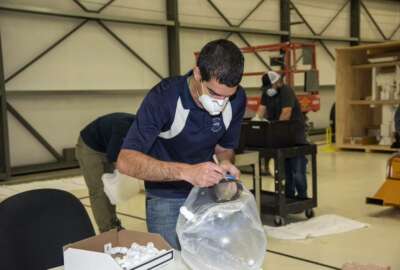
NASA’s unity campaign takes on new meaning during pandemic, protests
NASA's unity campaign launched last September, but it's taken on new meaning during the pandemic and recent nationwide protests. Under its unity initiative, NASA is...
When NASA astronauts view the Earth from outer space, they don’t see race, gender, religion or borders.
When they rise above the atmosphere, all they see is a blue, marble-like orb.
Reaching this kind of higher mindset is the intention behind NASA’s “unity campaign,” which the agency launched last September. The goal, said Steve Shih, NASA’s associate administrator for diversity and equal employment, is to rise above any artificial constructs and divisiveness and focus on a set of common goals.
“It’s about elevating and expanding individuals’ focus and mindsets from individual goals and agendas to a super-ordinate agency goal and higher purpose,” he said in an interview with Federal News Network. “It’s about moving people from ‘me’ to ‘we’ and ‘us.'”
As part of the unity initiative, NASA has been hosting dialogues and townhall meetings to collect employee feedback. Their comments will eventually inform a new NASA diversity and inclusion strategic plan, due in December. Individual NASA facilities and centers are also developing their own diversity and inclusion plans at the local level.
The planning and diversity dialogues were underway for some time, but Shih said the NASA unity campaign has taken on new meaning during the pandemic and recent nationwide protests.
“We are encouraging and emphasizing the importance of being intentional and strategic about actually connecting with each other. Because we’re doing that with this unity campaign designed and already implemented, we have a vehicle, a practice and natural initiative, which is actually connecting people and helping people to focus on connection as not just something spontaneous but also something that’s a strategic imperative.”
Because it’s more difficult for employees connect with one another organically in a virtual environment, NASA leaders have tried to be more intentional about reaching out to the workforce, Shih said.
The agency’s leaders, including the NASA administrator, have sent weekly messages to the workforce about diversity and inclusion and the importance of unity, he added.
Since social justice protests began in earnest back in May, diversity dialogues have been focused on specific race challenges, Shih said.
“There have been very candid and constructive dialogues. In some instances there have been some new information and surprises, some unknowns that surfaced,” he said. “But ultimately … the dialogues are facilitating a further enhancement of really positive relationships in the workplace, adding to that sense of trust and psychological safety, helping employees feel they can be safe and authentic — and to be themselves and fully contribute.”
NASA Administrator Jim Bridenstine in July announced the addition of “inclusion” as a fifth NASA value. Existing NASA values focused on teamwork, safety, excellence and integrity.
Earlier this summer, the agency renamed its headquarters after Mary Jackson, the NASA mathematician and civil rights activist who inspired the book and movie “Hidden Figures.”
Shih said NASA leaders are also writing a unity pledge, which the administrators will sign and post publicly. The agency is also developing new unity training courses for the workforce, as well as an orientation and onboarding materials for new employees.
The unity campaign has also given NASA a chance to take a fresh look at all of its personnel management, recruitment and hiring practices.
For Shih, NASA’s workforce is reasonably representative of the people it serves. Black and African American employees make up 11.5% of the NASA workforce and 11.9% of the agency’s Senior Executive Service.
Black and African Americans represent 18.1% of the agency’s IT workforce, which Shih said is better than the relevant civilian labor force proportion of 11.1%.
Around 3% of NASA’s physical scientists and 6.7% of the agency’s engineers are Black or African American. Black and African American engineers make up 3.5% and 4.8% of the relevant civilian labor force’s physical scientists and engineers, Shih said.
Still, he said NASA sees room for improvement.
“We’re taking a look at our staffing and our hiring practices to ensure that there are no built-in barriers or adverse impacts,” Shih said. “We’re also providing training on unconscious bias and looking at ways to do assessments focused in particular, on merit and performance-based competencies — in line with the direction that the administration has set.”
All of these activities are vital, Shih said, especially as baby boomer employees continue to retire — and NASA is forced to compete with a growing number of sectors, organizations and other countries that are doing similar work.
“Couple that with this pandemic challenge, which is creating impacts on the ability to work and balance family, child and senior care needs, we need to make sure that we’re at the top of game to be a model employer, to be able to recruit, hire, engage and retain top talent,” he said. “That means that we have to do everything possible to ensure that NASA continues to have its competitive advantage in our mission accomplishment, in the incredible work we do and the way that we treat our employees, so that people are going to want to come here to work with us and stay with us as well.”
Copyright © 2024 Federal News Network. All rights reserved. This website is not intended for users located within the European Economic Area.
Nicole Ogrysko is a reporter for Federal News Network focusing on the federal workforce and federal pay and benefits.
Follow @nogryskoWFED





